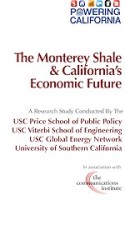 By Dennis Luna, J.D., P.E.
By Dennis Luna, J.D., P.E.
Development of the Monterey Shale could, over the next seven years, add 512,000 to 2.8 million new, high-paying jobs in California, increase income of the state’s residents by over $220 billion, and generate $24 billion in new tax revenues for state, county and local governments.
Those are the “conservative, median scenario” conclusions of a 71-page report, “The Monterey Shale & California’s Economic Future,” published by the USC Global Energy Network. The Network is a joint project of the Price School of Public Policy and the Viterbi School of Engineering, both of the University of Southern California. The Communications Institute, which supports nonpartisan analysis of public issues, collaborated on the project.
The study looked only at the economic effects of development of the Monterey Shale play. It noted that other important issues remain to be investigated by other researchers, including potential impacts on water supply, communities, air quality, greenhouse gases, seismic activity, and continued reliance on fossil fuels.
The study notes that crude oil production in California fell by 47% from 1985 to 2010. The state, once the third-largest producer, in ranks fourth behind Alaska, Texas and North Dakota. Because of fracking and horizontal drilling in North Dakota’s Bakken Shale play, production there has “soared from some 200,000 barrels per day in 2008 to more than 750,000 barrels per day in 2012.”
That upsurge has caused a boom in North Dakota’s economy, the study points out, with the state experiencing an average growth in gross domestic product of 6.7% per year from 2008 to 2011, the fastest in the nation. Unemployment is now 3.2%, the nation’s lowest.
Oil and natural gas developed by fracking of shale plays will have significant impact on America’s energy security. In November, the report points out, “The International Energy Agency projected that, by 2035, the United States would become 97% energy self-sufficient in net terms—a sharp reversal from historically persistent U.S. import-dependency.”
That doesn’t include possible impact from the Monterey Shale play, which has barely begun to be developed. In the Monterey Shale, “California boasts perhaps the largest deep-shale reserves in the world,” the report states.
The 1,750 square mile area, which runs from Bakersfield north to Modesto in the San Joaquin Basin, may contain 15 billion barrels of oil, according to the U.S. Energy Department, along with vast quantities of natural gas. That would amount to two-thirds of the nation’s shale oil reserves. (A private consulting firm has estimated the reserves at as much as 400 billion barrels.)
The USC researchers acknowledge that any forecast of economic activity years in the future is tenuous. They say they tried to “identify a range of the most likely patterns of development,” and to present “a set of conservative, median-scenario” results.
Extrapolating from what has happened in North Dakota, the team used sophisticated economic models to determine the “likeliest potential consequences” of development of the Monterey Shale. The key findings:
- Jobs – 512,000 additional jobs could be created by 2015, and 2.8 million by 2020. In later years the employment effect would decline slightly, to 2.6 million jobs in 20205 and 1.8 million jobs in 2030. (California’s non-farm workforce is now about 14.5 million.)
- Economic growth – gross domestic product per capita would rise by $1.6 billion in two years, by over $10 billion in seven years, and by $11 billion by 2025, then declining to $8 billion by 2030.
- Personal income –well-paying jobs created by development of the shale would increase total personal income of all Californian’s by $40 billion in 2015, and by over $200 billion through 2025, declining to a gain of $140 billion by 2030.
- Tax revenues – state, county and local governments would collect an additional $4.5 billion by 2015, rising to about $25 billion in 2020, $23 billion in 2025, and $15 billion in 2030.
Not only would unemployment fall, the authors say, but the oil boom would attract a “significant migration of properly skilled workers into California,” and would create openings for “Californians with appropriate education and training.”
The research was funded in party by a grant from the Western States Petroleum Association, “However, the study’s conclusions were independently researched by the study’s authors,” a summary of the report states.
The full report is available here. A four-page executive summary is available here.
Dennis Luna is the Editor In Chief of the California Oil and Gas Report and is Managing Partner of Luna & Glushon. He is considered one of the top energy and real estate attorneys in California. Dennis is a graduate of Harvard Law School and a licensed Professional Engineer. He holds a Master of Science in Petroleum Engineering from the School of Petroleum Engineering at the University of Southern California, where he also earned a Bachelor of Science in Petroleum Engineering and a Master of Business Administration.
